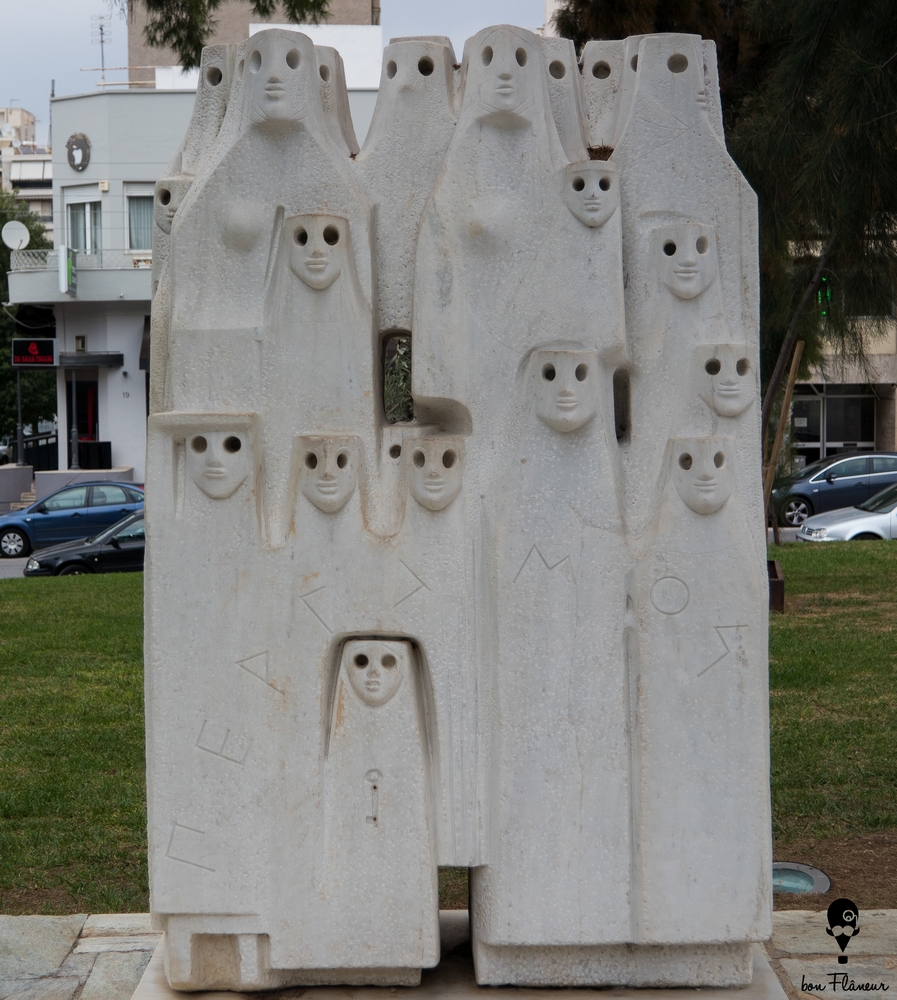Sculptures in Chrysostomou Smyrnis Square
The sculpture Refugees from Pergamon.
Location
Timeline
Modern and Contemporary era (1821 - )
The sculptures are of different chronologies of recent decades.

The sculpture Refugees from Pergamon.
Home > Athens > Culture > Modern art/ sculpture > Greater Athens > Sculptures in Chrysostomou Smyrnis Square




















Chrysostomou Smyrnis Square in Nea Smyrni is an outdoor sculpture gallery with works by Vassos Kapantais (1924-1990). It has seven major marble and bronze sculptures and busts of important personalities of Nea Smyrni and Smyrna (current Izmir). The theme of the sculptures is the uprooting of refugees from the region of Asia Minor immediately after the First World War and the Asia Minor Catastrophe: “Tombstone Victory” is dedicated to the casualties, the “Akritas of the Sea” to Pontian Greek refugees, “Ayvalik” to the namesake city of Asia Minor and the “Greek Boy Scout” to the fallen scouts. Of greater importance are perhaps “Smyrna”, in which a woman with child look to the distance at their lost homeland and “Refugees from Pergamum” (today a region of Turkiye [Turkey]), whose sharp figures have emphasized eyes expressing terror and suffering. The arrangement of the figures and shapes is reminiscent of the black and white photography of refugees from that era.
The area of Nea Smyrni (New Smyrna) was inhabited by refugees from 1922 to 1924, who came from the region of Smyrna and its surrounding areas. The sculptures were inspired by themes relating to refugees and the civilian casualties of the Greco-Turkish war. Under the Treaty of Sevres of 1920, the surrounding area of Smyrna came under Greek administration for two years. The rise of the “Great Idea” (that Greece would regain the greatness of the Byzantium) led to political arrogance, which in turn resulted in a Greek expedition to penetrate deep into present-day Turkiye (Turkey), and at the same time committing systematic acts of violence against the Muslim population. The disengagement of the allies from the war, the insatiable nationalism and political disputes in Greece and the Mustafa Kemal’s intelligent military strategy, led to the eventual defeat of the Greek army, the massive slaughter of civilians and the total destruction of Izmir. With the subsequent Treaty of Lausanne (1923), there was an exchange of populations, with Greeks from Asia Minor forced to move to Greece and Turks living in Greece to go to Turkiye (Turkey). Refugees lived with the hope of someday returning to their homes, a return that never happened.
Andriotis N., (2003), Οι πρόσφυγες, η άφιξη και τα πρώτα μέτρα περίθαλψης, [The refugees, the arrival and the first care measures] in Ιστορία του Νέου Ελληνισμού, 1770-2000, ο μεσοπόλεμος, 1922-1940, από την Αβασίλευτη Δημοκρατία στη Δικτατορία της 4ης Αυγούστου, [The History of modern Hellenism, 1770-2000, the interwar, 1922-1940, from the democray withoutking to the dictatorship of the 4th of August, v.7, p.p.79-88, Ellinika Grammata
Giannakopoulos G., (2003), Η Ελλάδα στη Μικρά Ασία, το χρονικό της Μικρασιατικής περιπέτειας 1919-1922, [Greece and Asia Minor, the chronicle of the Asia Minor adventure 1919-1922], στην Ιστορία του Νέου Ελληνισμού, 1770-2000, η εθνική ολοκλήρωση, 1909-1922, από το κίνημα στο Γουδί ως τη Μικρασιατική Καταστροφή, [The History of modern Hellenism, 1770-2000, the national completion, 1909-1922, from the Goudi movement until the Asia Minor Catastrophe v.6, p.p.83-95, Ellinika Grammata
Glyptothiki, (d.u.), Νέα Σμύρνη, [Nea Smyrni]
http://glypto.wordpress.com/category/%CE%BD%CE%AD%CE%B1-%CF%83%CE%BC%CF%8D%CF%81%CE%BD%CE%B7/,
Last visit 27/5/2013
Panagiotidis S., (2024), Μύθοι, παρεξηγήσεις και άβολες αλήθειες της ελληνικής ιστορίας, [Myths, misunderstandings and uncomfortable truths of Greek history], v.2, Kedros Publication
The sculptures are of different chronologies of recent decades.
Share